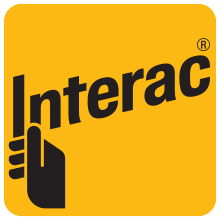Interac
Interac is a Canadian interbank network that links financial institutions and other enterprises for the purpose of exchanging electronic financial transactions. Interac serves as the Canadian debit card system. There are over 59,000 automated teller machines that can be accessed through the Interac network in Canada, and over 450,000 merchant locations accepting Interac debit payments.
 | |
| Operating area | Canada |
|---|---|
| Members | 83 |
| ATMs | 59,000 |
| Founded | 1984 (as Interac Association) 1 February 2018 (as Interac Corporation) |
| Owner | Interac Corporation |
| Website | interac.ca |
History
| Industry | Financial services |
|---|---|
| Predecessors |
|
| Founded | February 1, 2018 |
| Headquarters | |
| Website | www |
The network was launched in 1984 through the nonprofit Interac Association, a cooperative venture between five financial institutions: RBC, CIBC, Scotiabank, TD, and Desjardins; by 2010, there were over 80 member organizations. The group founded a for-profit counterpart organization, Acxsys, in 1996, which launched additional Interac-branded services including e-transfers. Following several aborted merger attempts which were either blocked by the Competition Bureau or by some of the co-owners between 2008 and 2013, Interac and Acxsys were combined into a single for-profit organization, Interac Corporation, on 1 February 2018.[1][2] Interac's head office is located at Royal Bank Plaza in Toronto.
Services
Interac is the organization responsible for the development of a national network of two shared electronic financial services:
Interac Direct Payment (IDP)
Interac Direct Payment (IDP) is Canada's national debit card service for purchasing of goods and services. Customers enter their personal identification number (PIN) and the amount paid is deducted from either their chequing or savings accounts. As of 2001, the number of transactions completed via IDP has surpassed those completed using physical money.[3] Beginning in 2004, IDP purchases could also be made in the United States at merchants on the NYCE network. IDP is similar in nature to the EFTPOS systems in use in the United Kingdom, Australia and New Zealand.
Interac Direct Payment is a PIN-based system where the information entered on the PIN pad is encrypted and verified at a central server, rather than being stored on the card itself. Because of this, it is significantly more secure than traditional signature or card-based transactions. Despite these security features, there are ongoing fraud concerns, particularly when debit cards are duped or skimmed — a compromised automated teller machine or point-of-sale terminal will record the account information contained in the magnetic strip of the card, allowing for duplicate cards to be created at a later time. The owner of the card is then secretly video taped or observed entering their PIN, allowing a criminal to use duplicate cards to make fraudulent purchases.
Interac chip cards
In 2007, Interac announced it would be moving to EMV chip card technology.[4][5] The main benefit to this technology over the existing magnetic stripes is that the chips are almost impossible to copy due to high levels of encryption.
Shared Cash Dispensing (SCD)
Shared Cash Dispensing (SCD): cash withdrawals from any ABM not belonging to a cardholder's financial institution. This Canada-specific service is similar to international systems like Plus or Cirrus. Virtually every ABM in Canada is on the Interac system.
Interac e-Transfer Service
The Interac e-Transfer service is offered by CertaPay. It allows online banking customers to send money to anyone with an e-mail address and a bank account in Canada. Prior to February 2018, this was an Interac-branded service operated by Acxsys Corporation.
Interac Online
The Interac Online service allows customers to pay for goods and services over the Internet using funds directly from their bank accounts. Because no financial information is shared with the online merchant, the Interac Online service is more secure than online credit card payments. This service, an Interac branded service operated by Acxsys Corporation prior to February 2018, began in 2005 and is expanding as more merchants choose to participate. Since November 2007, the service has been available to customers of four of the five largest Canadian banks: RBC, BMO, Scotiabank, and TD Canada Trust. CIBC, the sole outlier, uses Visa Debit for online payments from bank accounts. As of February 2009, the service is offered by roughly 300 merchants including two large universities (for tuition payments), two major wireless carriers, provincial lottery corporations, and a wide variety of retailers. Interac Online is an Online Banking ePayments service very similar to iDEAL in the Netherlands, Giropay[6] in Germany, and Secure Vault Payments[7] in the United States.
See also
References
- The Canadian Press (12 February 2010). "Bureau axes Interac request to become for-profit". CTV News.ca. Bell Media. Retrieved 18 October 2013.
- Bradshaw, James (5 February 2018). "Major revamp gives Interac a chance to compete against rivals". The Globe and Mail. Retrieved 12 February 2018.
- Buchholz, Garth A. (22 July 2005). "INTERAC Milestones in Canada | Electronic Cash Payments: Canada Loves its Debit Cards, but Will the Cashless Revolution Happen in the U.S.?". InformIT. Pearson Education. Retrieved 18 October 2013.
- "What is Chip Technology | Interac". Interac.ca. 31 December 2012. Retrieved 18 October 2013.
- "Interac Association Chip Guide". EPOSS. Archived from the original on 7 January 2016. Retrieved 22 May 2014.
- "Home: giropay" (in German). Giropay.de. 18 September 2013. Retrieved 18 October 2013.
- "Fast. Easy. Secure". Secure Vault Payments. Retrieved 18 October 2013.
Bibliography
- Interac Association (2006). At the Merchant 2006. Retrieved 19 June 2006, from https://web.archive.org/web/20060717152738/http://www.interac.ca/en_n2_11_howitworks.html
- Interac Association (2006). At the Merchant 2006. Retrieved 19 June 2006, from https://web.archive.org/web/20060721144717/http://www.interac.ca/en_n2_12_benefits.html
- Interac Association (2006). At the Merchant 2006. Retrieved 19 June 2006, from https://web.archive.org/web/20060718165146/http://www.interac.ca/en_n2_13_fees.html